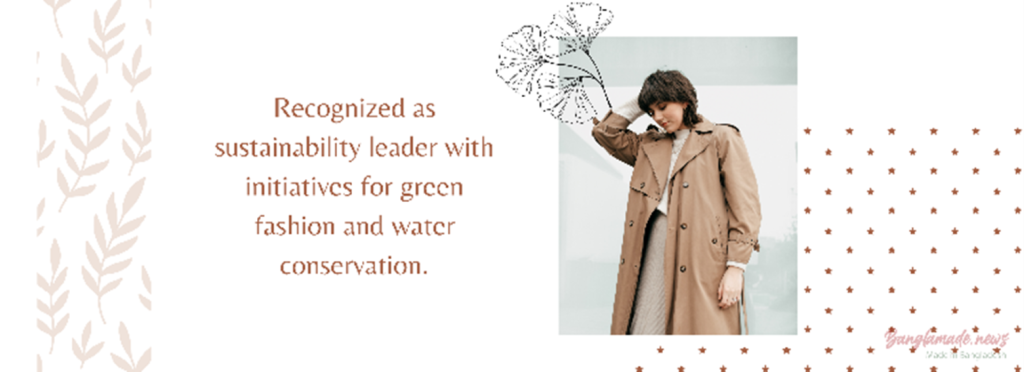
H&M Group has released its 152-page annual and sustainability report for 2022, Outlining Ambitious Goals for the Future H&M Group, the Swedish multinational clothing-retail company, has released its annual and sustainability report for 2022, highlighting its commitment to sustainability and transparency in its fashion brand offerings. The report includes comments from the CEO, a description of the business, legal annual report, corporate governance report, administration report, and financial reports. The report complies with Swedish and EU legislation and international financial reporting standards. It also includes information on sustainability strategy, policies, goals, programs, and performance data. The report uses terms such as circular and circularity to describe activities aligned with the Ellen MacArthur Foundation’s definition of a circular economy. H&M Group’s sustainability approach includes circular business models, fair compensation in their production supply chain, and sourcing materials in a more sustainable way. They prioritize innovation and collaboration to reduce their environmental impact and respect human rights. The company faced challenges in 2022 due to the war in Ukraine and high inflation but continued to prioritize customer value and invest in their sales channels. They invest in projects to reduce emissions throughout their value chain and have established the Green Fashion Initiative to support their suppliers in replacing fossil fuels. H&M Group values respect for individuals and fair labor standards across their operations and supply chain. They strive to be a fair, equal, and relevant employer, with a diverse workforce from different nationalities. The company aims to scale circular models and systems for its products, supply chains, and customer journeys, and promote transparency and collaboration for industry-wide progress. The company is committed to advancing the human rights.

H&M’s CEO letter reflects on the challenges of 2022, including the humanitarian crisis in Ukraine, the negative effects of the pandemic, high inflation, and the impact of these external factors on the company’s results. Despite this, H&M achieved a 12% increase in full-year sales and broadened its customer offering by launching H&M Move. Other brands, such as COS and Weekday, saw a 22% increase in sales. H&M also continued to provide recycling services and invest in sustainability, with an ambitious goal of reducing greenhouse gas emissions by 2030. The letter also discusses the integration of physical and digital sales channels, with investments in tech and AI. H&M initiated a cost and efficiency program in the autumn of 2022 to counter the cost increases and the shift in the industry, which is expected to have positive effects in the second half of 2023.
The H&M Group has reported net sales of SEK 224 billion, representing a 12% increase from the previous year. Online sales accounted for about 30% of the group’s total net sales, while 75% of positions of responsibility were held by women. The group converted 150,000 employees into full-time positions, with a total of 106,522 new full-time positions. The group achieved its plastic reduction target of 25% ahead of time, with a 44% absolute reduction in plastic packaging compared to the 2018 baseline. 84% of the group’s commercial goods are made from recycled or sustainably sourced materials, while 23% of the goods are made from recycled materials. The H&M Group’s cash flow from operating activities was SEK 24 billion.

Recognized as sustainability leader with initiatives for green fashion and water conservation.
In 2022, H&M Group was recognized for the 11th year running as one of the leaders in environmental, social and governance performance, included in the Dow Jones Sustainability World Index. The second-hand platform Sellpy increased its sales by 85% and is expected to exceed 1 billion SEK in sales in 2023. H&M established the Green Fashion Initiative to support its suppliers in replacing fossil fuels, with 17 approved projects as of January 2023. The company achieved CDP scores of A- in the climate module, and its climate goals were verified by the Science Based Targets initiative. H&M opened stores in new markets and signed long-term virtual power purchase agreements to cover electricity consumption in its operations in European markets. The company launched its Water Strategy 2030, reduced its relative water consumption in its supply chain by 38%, and was ranked fourth out of 250 fashion brands and retailers reviewed by Fashion Revolution’s 2022 Fashion Transparency Index. H&M aims to grow its business in a sustainable manner that decouples its financial growth and profitability from the use of finite natural resources.

H&M Takes Steps Towards Industrywide Standards for Product Transparency
H&M has revealed its intention to create industrywide standards for product transparency to improve levels of transparency and to identify faults and opportunities for improvement to drive positive change. The company has made its supplier list public, tested and piloted industry comparable impact data on product level, and scaled its traceability program with Textile Genesis to several pilots using blockchain technology in 2022. H&M also initiated the process for tracing over 200 million pieces on the Textile Genesis platform, and approximately 44 million pieces have so far been fully traced. The company welcomes harmonized legislation and guidance to ensure standardization around sustainability claims.

Sustainability
H&M Group has a strong commitment to sustainability, which is integrated into every aspect of its business. The company’s sustainability goals, which include reducing greenhouse gas emissions, using sustainable materials, and reducing water usage, are based on the latest science and best practices. H&M believes that sustainability is critical to its business and that investing in sustainability provides long-term business opportunities. The company’s vision is to lead the fashion industry towards a circular model with net-zero climate impact while promoting fairness, equality, and human rights. H&M Group aims to achieve its goals through collaboration, innovation, and transparency.

H&M’s Board
H&M’s Board of Directors manages the company’s affairs in the interest of the company and its shareholders, safeguarding and encouraging a good corporate culture. In 2022, the board’s work was challenging due to geopolitical and macroeconomic factors, leading to the decision to wind down business in Russia and manage high inflation. This led to discussions on the customer offering and pricing, supply chain, sustainability, tech, and communication. H&M also introduced a global program to reduce costs and improve efficiency. The board also evaluates its work, focusing on working methods, the working climate, and specialist expertise within the board. The audit committee monitors the company’s financial reporting and assists the nomination committee in electing auditors. The CEO is responsible for the daily management of the company, including recruitment of senior executives, buying and logistics matters, sales and profitability, and sustainability matters.

Sales and Financial Performance
The company faced challenges in 2022 due to the war in Ukraine and high inflation but continued to prioritize customer value and invest in their sales channels. The company’s net sales for 2022 were SEK 223,553 million, with a decrease in sales in some regions due to the impact of the war and store closures in Russia, Belarus, and Ukraine. Despite external factors affecting their purchasing costs, they expect 2023 to be a year of increased sales and improved profitability.

2030 Goals
H&M Group has set ambitious sustainability goals, including becoming net-zero across its value chain by 2040, supporting a circular fashion industry with net-zero climate impact, and having a net positive impact on biodiversity. The company aims to double its sales while halving its greenhouse gas emissions by 2030.

Human Rights
H&M Group values respect for individuals and fair labor standards across their operations and supply chain. They strive to be a fair, equal, and relevant employer, with a diverse workforce from 175 nationalities.

H&M’s 2022 Administration, Business Ventures, and Integrated Channels
H&M Hennes & Mauritz AB (publ) submitted its annual report for the financial year 2022, highlighting its commitment to delivering sustainable and profitable growth through various business ventures and an integrated omnichannel strategy. The H&M group is a responsible fashion and design company that focuses on delivering value to its customers through sustainable means. The group operates several brands, including H&M, COS, Monki, and Weekday, and has business ventures such as Afound, Singular Society, and Creator Studio. In 2022, the company continued to work on its business plan to deliver long-term sustainable growth, which aims to make fashion and design accessible to everyone while reducing negative impacts on the planet. H&M aims to shift to more circular business models and increase the percentage of recycled and sustainably sourced materials in their collections. The group’s integrated omnichannel strategy involves opening new stores, optimizing existing stores, and expanding its digital channels, including digital marketplaces and social media. The company will also continue to renegotiate leases to ensure the best store portfolio in each market. The plan for 2023 is to open about 100 new stores and close about 200 stores, resulting in a net decrease of around 100 stores.
